Salon
BagNewsSalon: The Visual Framing of “The Great Recession”
In Collaboration with Open-i
The most recent BagNews Salon, held on October 16th in collaboration with Open-i, brought together photographers who have been covering the recession in depth and academics specializing in the visual rhetoric of poverty and social welfare. Watch the full archive or read salient quotes from the conversation below.
Images and Selected Quotes
Co-Produced for BagNews by Ida Benedetto
Introduction
Michael: The visual depiction of the great recession, officially starting in December 2007 precipitated by the mortgage meltdown and the ensuing banking crisis, represents a huge landscape of imagery spanning multiple phases and dozens of scenes. In this instance, rather than offer a representative edit which is always a challenge, we instead decided to focus on a group of distinguished photojournalist who have been covering the recession in depth. From their we selected from their photos, avoiding anything that was too iconic or tradition, to offer the greatest breadth when it comes to the myriad of themes from the recession. Is it is a pleasure to have these photographers here today along with a distinguished group of academics specializing in visual rhetoric of poverty and social welfare.
Nathan: I’m really overwhelmed by how difficult it is to see the recession. As Michael said, it covers a lot of time, space and conditions, but something that effects so many people still being essentially invisible is a very powerful problem.
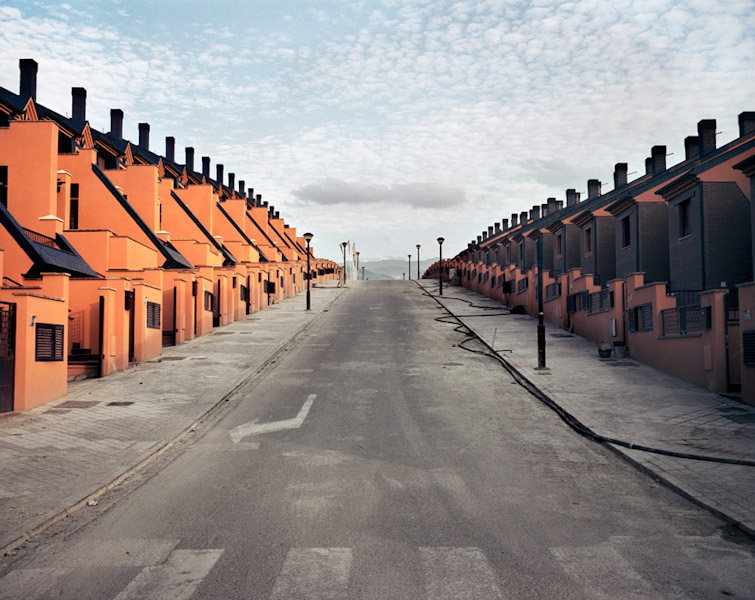
(photo: Ben Roberts. caption: Calle Ojos Del Salado – unoccupied housing estate, Granada – September 27, 2007.)
Loret: We are accustomed to seeing places that have already been lived in and subsequently abandoned. With this recession, we’re seeing new enterprises that were build before the economy tanked and are now left empty. This is a new kind of image of loss. We are accustomed to looking at what used to be so we have a nostalgia, a sadness. Here is actually a loss of what was anticipated and expected.
David: This has some interesting formal qualities that are aesthetically enticing while the subject matter and the issues at hand run almost counter to the formal nature of the image.
Nathan: From a different point in time, this could seem like a space to live in and has a need to be lived it rather than a space that cannot be lived in or is abandoned or is excessive. These are built on the expectation that we are supposed to want this when really it is completely dislocated or separate from people’s reality and what they can do. It’s quite jarring.
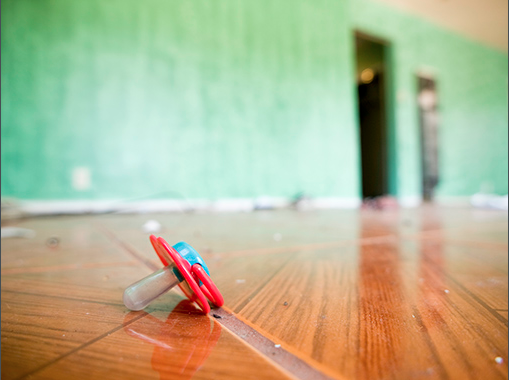
(photo: David H. Wells / Foreclosed Dreams. caption: The empty homes and foreclosed dreams littering the American landscape.)
David: I’m going into houses after the foreclosure happens but before they’ve been cleaned up to photograph the ghosts. From the things that people leave behind, you can get a sense of what happened there before. It’s not so much about the people. It’s more of the formal qualities. Photojournalism is a competitive market, and I wondered what I could do with photography is as powerful as some of the other people in this salon. I wasn’t 100% sure that I could do that. I wanted to come up with a visual aesthetic and a journalistic strategy in my head and play with it in the field for a while.
Michael: In Ben Robert’s shot [above] it felt like all the oxygen had been sucked out of that housing development. Here you almost fill in with your mind all of the objects that have been removed from this very domestic, personal space. I find this pretty haunting actually.
Nathan: One similarity in these last two photos in terms of formal qualities is really strong color contrast. In this photo, much of the contrast is in the grey street and the orange house. Here it’s the wood floor and the green wall. The visual starkness along with the emptiness really reinforces the sense of deprivation.
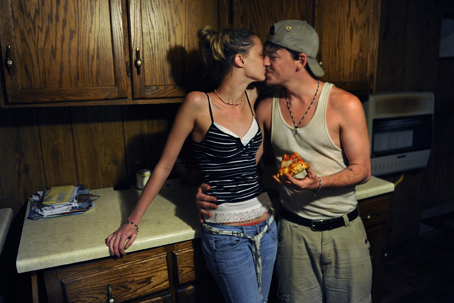
(photo: Michael Williamson / The Washington Post. caption: Justin Hamby and Holly Rogers share a kiss as they eat pizza in the kitchen of their home in Oneida, Tennessee. They were recently married and are saving to purchase her wedding ring, which is on layaway at a nearby Walmart.)
Michael W.: With Walker Evans’ photos 50 years later many people say that ‘He froze me in time. But I wasn’t frozen in time. In fact, I got a new Sunday dress a week after he photographed me wearing a flour sack.’ While most people stayed in the same position, many resented that they were in history books and on walls of museums when they had changed dramatically even just weeks after his photos were taken. I was very aware of this. On this project that I’m on right now, the recession review, much of my work is following up with the people I photograph two years ago. The changes are dramatic in both directions. Either people are much worse off or people have found ways to reinvent themselves. The follow up gives additional context that the original image can’t offer.
Michael: This photo speaks to resilience and heartiness. It is so easy to stereotype people and show them as despondent because of the recession, but this image went in a different direction. You see the pile of letters there, and you can imagine all this bad news coming out of those envelopes. There is this resilience like ‘So what, we can live on pizza.’ You also see a little of her underwear there. There is something sensuality and sexuality to this picture which I think drives home that spirt.
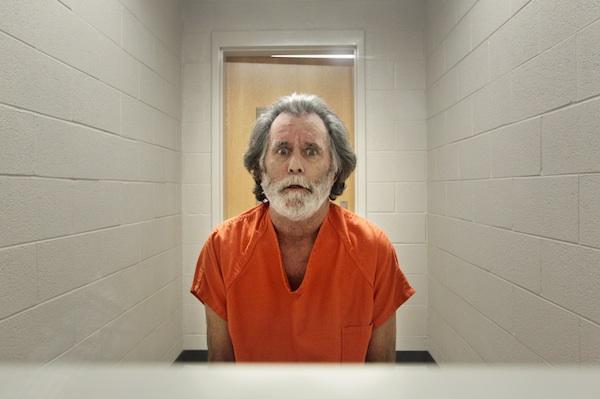
(photo: Ben Goff / The Gazette. caption: James Richard Verone, who held up a bank for $1 in the hopes of getting medical care in prison, peers through the glass of a visitation booth at the Gaston County Jail on Thursday June 16, 2011, where he is being held while awaiting trial.)
Nathan: The crazy look in his eyes makes it very easy to place him outside the conversation, when he’s not really. It raises the question of who’s really sick, him or us, us being society.
Cara: This is a photo about the viewer as much as anything else and the extent to which we say, “Well, why does this guy look like this? What’s he doing here? What’s the story?” Images like this can be ingenious in that it’s turning the situation right back on us.
Andrew: If you compare this to Migrant Mother by Dorothy Lang, which has become iconic of the Depression, they can talk to each other. This is the contemporary update. Obviously it’s different body language and gender, but this one he’s looking directly at the viewer whereas in Migrant Mother, she’s looking off into space. That might be able to tell you something about that Depression and this Recession.
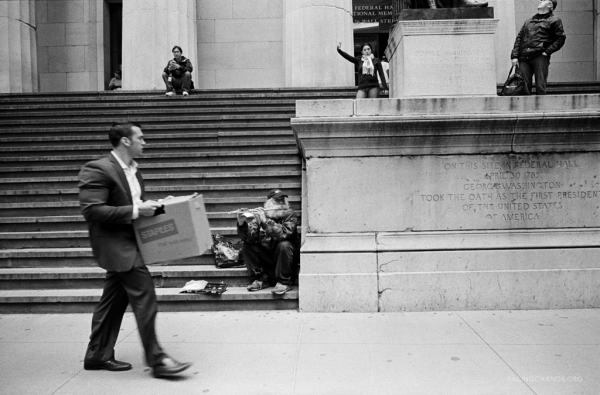
(photo: Anthony Suau / Facing Change. caption: Wall Street traders, investment bankers, musicians, preachers, policemen, security guards, military personal and tourists all make Wall Street and the New York Stock exchange an ever changing three-ring circus where the world of finance and trade come together within a few blocks.)
David: Each person is in their own mental time zone. I take that as an allusion to the social disconnection that is probably at the core of how we ended up in this mess.
Loret: The way my eye traveled through the frame was to see the man carrying the box, passing the site before our first president took his oath. It makes me wonder if the man carrying the box has the contents of his office and that he’s been downsized. I start looking around at each of the figures and wonder what they represent. The text indicates that this is the site where the first president took his oath. It brings us back to the question, could Washington have predicted this at the state of affairs now.
Michael W.: The power of this picture for me is this worker, who has been downsized or is changing offices or something, crossing paths with this guy [playing the flute on the steps] who is his future. And it might not be his distant future. It might be his near future. The top three people are everything in between
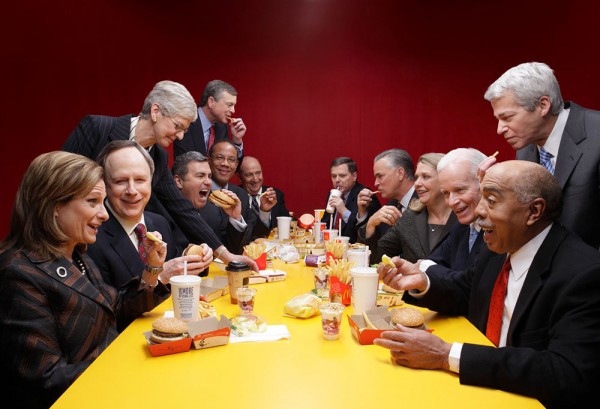
(photo: Ben Baker / Redux. caption: The economic meltdown has cast new light on what goes on inside America’s boardrooms. We offer a gallery of directors of the 500 companies and groups that affect them. With offerings like the Dollar Menu, McDonald’s has thrived in the recession, welcoming 58 million customers a day – up 2 million from a year ago. Profits climbed 80% last year, to $4.3 billion.)
Cara: They’re all pretending to eat for the most part. It’s a performance that is really offensive to the people who rely on their very cheap meals to eat.
Nathan: This is one of those images that actually makes the recession invisible. The other images are trying to help us see it. This is designed to do the opposite. It hides it behind a burger.
Michael W.: This is the creepiest photo I’ve seen in years because the whole point of the haves and have nots is that the haves are so disconnected. The fact that the they think this would be funny and cute and they would be connecting with the regular people with the dollar menu, and they would not see that that imagery or symbolism would be a slap in the face is informative… I’m falling off my chair with this picture.
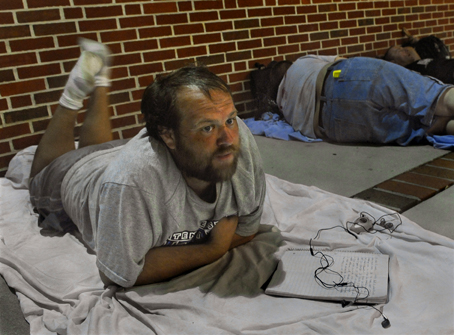
(photo: Michael Williamson / The Washington Post. caption: Three months before we found him sleeping on the streets of Orlando, Richard Scott Archer Jr. had a job, an apartment and a girlfriend.)
Michael: This image starts to move in a more iconic sphere. Especially when you know the context and you read the caption. The guy is very thoughtful and contemplative. Even with his feet, it feels like a playful motion. It shows resilience in a different way. Of course, the woman off to the right might just be sleeping, but it does highlight how alive and present this guy is even in what are clearly dire circumstances for him.
The Full Edit
Take a closer look at some of the images from our larger photo edit.







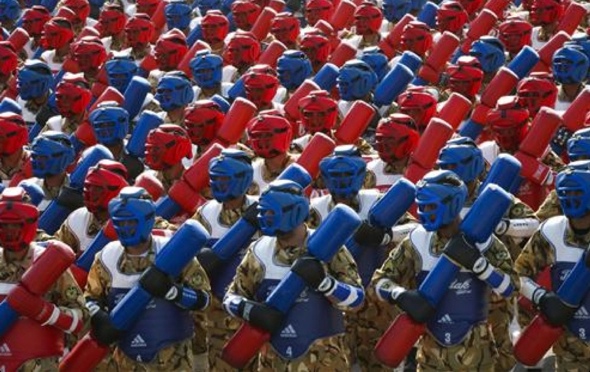

Reactions
Comments Powered by Disqus